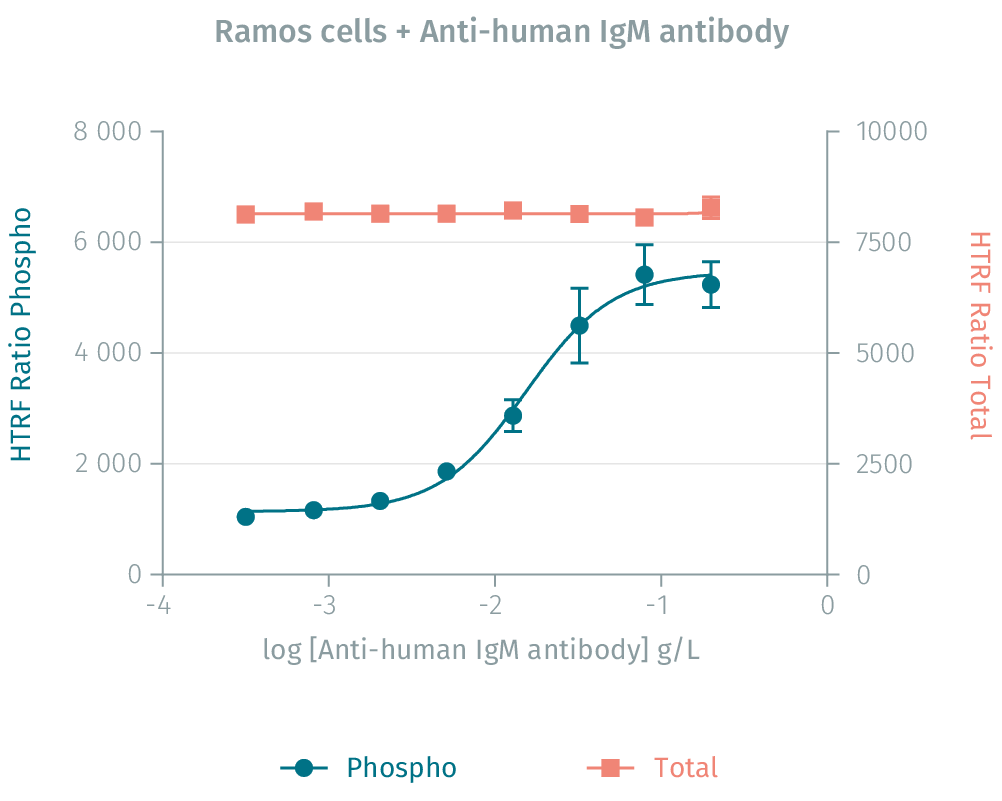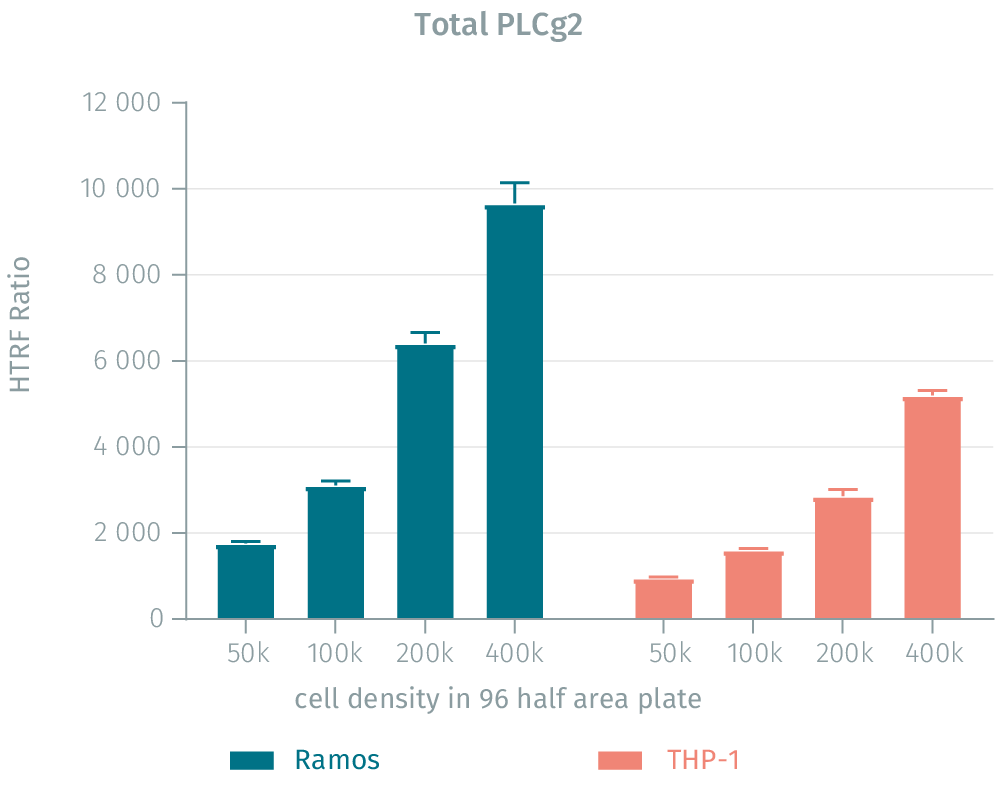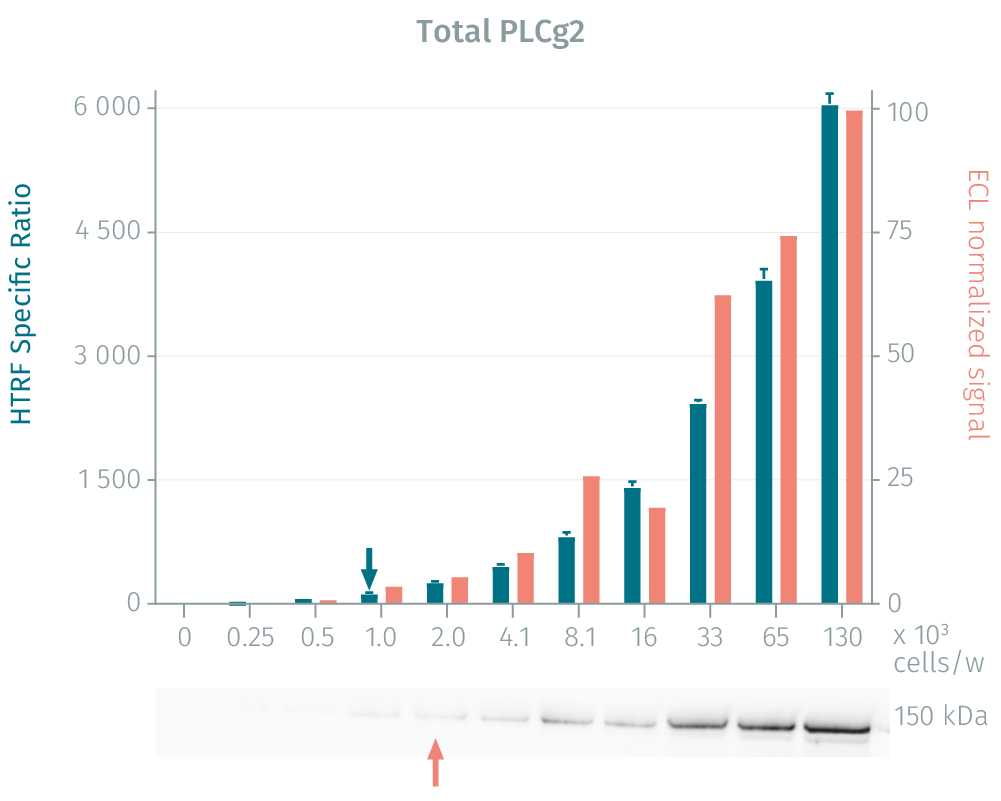

HTRF Human Total PLCg2 Detection Kit, 10,000 Assay Points






The Total PLCg2 kit is designed to monitor the expression level of cellular PLCg2 (Phospholipase C), and can be used as a normalization assay for the Phospho-PLCg2 (Tyr1217) kit.
For research use only. Not for use in diagnostic procedures. All products to be used in accordance with applicable laws and regulations including without limitation, consumption & disposal requirements under European REACH regulations (EC 1907/2006).
Product information
Overview
This HTRF cell-based assay conveniently and accurately detects Phospholipase C gamma 2 (PLCgamma 2) protein.
PLCgamma 2 is a phosphoinositide-specific phospholipase that generates second messengers and plays a crucial role in signal transduction, especially in haematopoietic cells such as B cells, mast cells, macrophages, natural killer cells and platelets. Upon stimulation of different receptors such as B-cell antigen receptor (BCR) and Fc receptors (FcRs), PLCgamma 2 interacts with several adapter proteins and becomes phosphorylated by intracellular tyrosine kinases. Phosphorylation includes several sites, one of which is Tyr1217.
PLCgamma 2 has been linked to various pathologies such as auto-immune and inflammatory diseases, drug-resistance in cancer and neurodegeneration.
Specifications
| Assay Points |
10000
|
|---|---|
| Assay Target Type |
Kit
|
| Assay Technology |
HTRF
|
| Brand |
HTRF
|
| Quantity |
1
|
| Therapeutic Area |
Neuroscience
Oncology & Inflammation
|
| Unit Size |
10,000 Assay Points
|
Video gallery


How it works
Total-PLCg2 assay principle
The Total PLCg2 assay quantifies the expression level of PLCg2 in a cell lysate. Unlike Western Blot, the assay is entirely plate-based and does not require gels, electrophoresis, or transfer. The Total-PLCg2 assay uses two labeled antibodies, one coupled to a donor fluorophore and the other to an acceptor. Both antibodies are highly specific for a distinct epitope on the protein. In the presence of PLCg2 in a cell extract, the addition of these conjugates brings the donor fluorophore into close proximity with the acceptor and thereby generates a FRET signal. Its intensity is directly proportional to the concentration of the protein present in the sample, and provides a means of assessing the protein's expression under a no-wash assay format.

Total-PLCg2 two-plate assay protocol
The two-plate protocol involves culturing cells in a 96-well plate before lysis, then transferring lysates to a 384-well low volume detection plate before the addition of Total-PLCg2 HTRF detection reagents. This protocol enables the cells' viability and confluence to be monitored.

Total-PLCg2 one-plate assay protocol
Detection of Total PLCg2 with HTRF reagents can be performed in a single plate used for culturing, stimulation, and lysis. No washing steps are required. This HTS designed protocol enables miniaturization while maintaining robust HTRF quality.

Assay validation
PLCg2 activation in anti-IgM-stimulated Ramos B cells
The human B cell lymphoma Ramos cell line was seeded in a half area 96-well culture-treated plate at 400,000 cells/well in 25 µL of FBS-free culture medium. After a 3 hour incubation at 37 °C, 5% CO2, cells were stimulated with 5 µL of increasing concentrations of an anti-human IgM antibody for 5 minutes, and then lyzed with 10 µL of supplemented lysis buffer #4 (4X) for 30 minutes at RT under gentle shaking. For the detection step, 16 µL of cell lysate were transferred into a 384-well low volume white microplate and 4 µL of the HTRF Phospho-PLCg2 (Tyr1217) or Total-PLCg2 detection reagents were added. The HTRF signal was recorded after an overnight incubation.
The anti-human IgM antibody induced a dose-dependent increase in PLCg2 phosphorylation at Tyr1217 without changing the expression level of the protein, demonstrating the activation of the BCR complex at the cell surface.

Cell density in Ramos and THP-1 cells
The human B cell lymphoma Ramos and monocyte THP-1 cell lines were seeded in a half area 96-well culture-treated plate in 30 µL complete culture medium. After a 3 hour incubation at 37 °C, 5% CO2, cells were lyzed with 10 µL of supplemented lysis buffer #4 (4X) for 30 minutes at RT under gentle shaking. For the detection step, 16 µL of cell lysate were transferred into a 384-well low volume white microplate and 4 µL of the HTRF Phospho-PLCg2 (Tyr1217) or Total-PLCg2 detection reagents were added. The HTRF signal was recorded after an overnight incubation.
Expression of total PLCg2 is twice as high in Ramos cells as in THP-1.

HTRF total PLCg2 assay compared to Western Blot
The human B cell lymphoma Ramos cell line was cultured in a T175 flask in complete culture medium for 48h at 37 °C, 5% CO2. After centrifugation, pelleted cells were stimulated with 20 µg/mL of an anti-human IgM antibody for 5 minutes. Then lysis buffer #4 (2X) was added for 30 minutes at RT under gentle shaking.
Serial dilutions of the cell lysate were performed using supplemented lysis buffer, and 16 µL of each dilution were transferred into a low volume white microplate before the addition of 4 µL of HTRF total PLCg2 detection reagents. Equal amounts of lysates were used for a side by side comparison between HTRF and Western Blot.
Using the HTRF total PLCg2 assay, 1,000 cells/well were enough to detect a significant signal, while 2,000 cells were needed to obtain a minimal chemiluminescent signal using Western Blot. Therefore in these conditions, the HTRF phospho-PLCg2 assay was twice as sensitive as the Western Blot technique.

Simplified pathway
Simplified pathway of PLCg2 signaling
PLCg2 (Phospholipase C gamma 2) is a cytoplasmic tyrosine kinase which plays a crucial role in signal transduction, especially in immune cells such as B cells and microglia (brain-resident macrophages).
Upon stimulation of B cells or TREM2/DAP12 receptor complexes, PLCg2 interacts with SYK, BTK and BLNK (also called SLP-65), leading to its activation by phosphorylation of its catalytic domain at Tyr1217. PLCg2 will then cleave the phospholipid phosphatidylinositol 4,5-bisphosphate (PIP2) into diacyl glycerol (DAG) and inositol 1,4,5-trisphosphate (IP3). IP3 will then increase calcium release and degradate it in IP1.
This will trigger the activation of multiple signaling pathways and cellular responses, including cell activation, proliferation, and survival.

Resources
This guide provides you an overview of HTRF applications in several therapeutic areas.

SDS, COAs, Manuals and more
Are you looking for technical documents for this product. We have housed them in a dedicated section., click on the links below to explore.


How can we help you?
We are here to answer your questions.






























